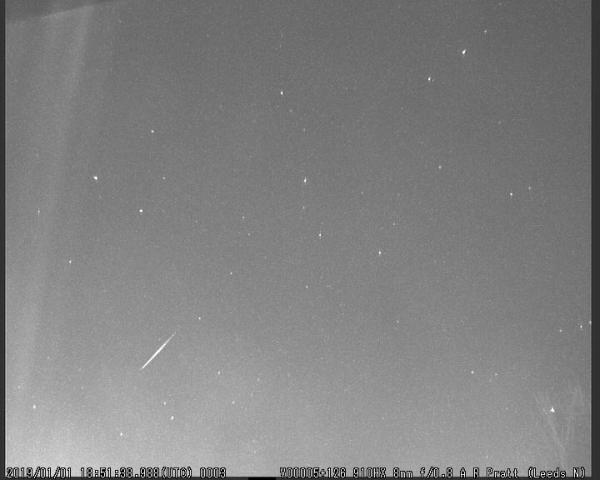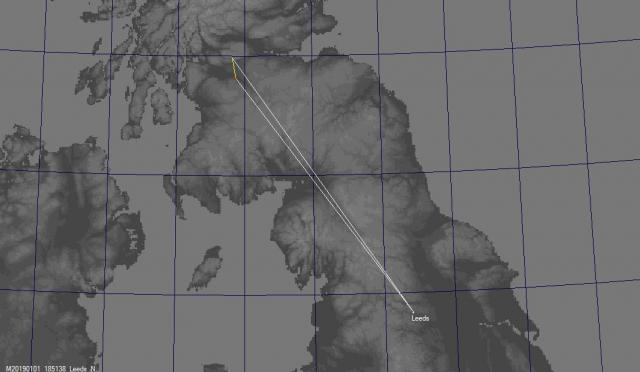- This topic has 10 replies, 5 voices, and was last updated 5 years, 3 months ago by
 Bill Ward.
Bill Ward.
-
AuthorPosts
-
3 January 2019 at 3:19 pm #574225
 Bill WardParticipant
Bill WardParticipantHi,
When I started to use 12mm lenses a number of years ago the larger image scale began to show some meteors that appeared to “melt” out of existence. These just faded away. I finally captured a decent spectrum of one of these the other night. Perhaps unsurprisingly a stony characteristic was revealed, the main elements being Mg and Na with Fe lines being nicely resolved.
There just might be the hint of some fragmentation seen in the video but it’s difficult to be sure as the cropped video also reveals the noise! Whatever the source the meteoroid must have had a weak or fractured structure to fall apart in this manner.
Perhaps a “dustball” as they have been called.
Cheers,
Bill.
3 January 2019 at 9:36 pm #580466 Alex PrattParticipant
Alex PrattParticipantHi Bill,
That’s a nice example of this type of dissolving meteor trail. I’ve had very cloudy skies and the only meteor recorded so far this year by my Leeds_N camera looks to be your event!

From my viewpoint the meteor travelled from upper right to lower left.

Does this ground map approximately match your alignment?
Single station analysis of my capture suggests it was an Ursid meteor. I’ll ask if it was recorded by any other stations in the NEMETODE network then we can confirm its radiant and orbit.
A great start to the New Year.
Alex.
3 January 2019 at 10:32 pm #580467 Bill WardParticipant
Bill WardParticipantHi,
That’s looking good. It is indeed an excellent start to the year. I had hoped the cloud would break for tonight’s Quadrantid’s but it’s looking absolutely solid. Not a breath of wind.
Cheers,
Bill.
4 January 2019 at 1:10 pm #580468 Jeremy ShearsParticipant
Jeremy ShearsParticipantNice capture Bill. Sadly, not caught on my video cameras.
Was just checking both cameras and I see it cleared here after midnight last night, allowing a few Quadrantids to be captured.
Jeremy
4 January 2019 at 5:40 pm #580469 Mr Jack MartinParticipant
Mr Jack MartinParticipantBill,
Thanks for an interesting video and spectrum to show what its composed of.
Regards,
Jack
Essex UK
5 January 2019 at 5:24 pm #580473 Bill WardParticipant
Bill WardParticipantHi,
Thanks, Having caught quite a number of this type I was always on the lookout for a spectrum of one. They have definite mechanical/fragmentation properties and I was hoping it would be somehow different it spectroscopic composition. Maybe very high or very low in some element but it doesn’t seem so with what I have here. The other possibility is that there are some IR features (which I didn’t get with this example) that may show the differences. perhaps very strong O and H lines indicating the possibility some ice content….
However, it is yet another example of the power of this technique that we can even ask these questions!
Clear skies and all the best for 2019
Cheers,
Bill.
PS will you be attending the astrofest in February? perhaps we can meet for a drink.
5 January 2019 at 5:27 pm #580474 Bill WardParticipant
Bill WardParticipantHi,
Thanks, I have always found it intruiging that, on varying scales, this is how we came to be. All that iron, magnesium, calcium etc that’s in us!
All the best for 2019.
Cheers,
Bill.
5 January 2019 at 10:34 pm #580480 Michael O’ConnellParticipant
Michael O’ConnellParticipantBill,
Great results as always.
What we need next is a 100mm lens on a tracking mount….
But seriously, have you ever considered building a tracking station?
Regards,
Michael.
7 January 2019 at 6:36 pm #580495 Bill WardParticipant
Bill WardParticipantHi,
Yes (ish)… Full tracking is way beyond my progamming skills but I think using a rotating mirror system one could build something that would at least “slow” them down along one axis. That would certainly help but then there is still the coverage issue.
Probably my only regret leaving the university is not having access to an optical lab and workshop where I can experiment anymore.
cheers,
Bill.
5 February 2020 at 9:49 pm #582011 Bill WardParticipant
Bill WardParticipantHi,
I captured another remarkable “melting” meteor last night. Meteor seems to fragment into a “cloud” of material then trail behind the faster moving meteor head.
Cheers,
Bill.
19 September 2020 at 2:22 pm #583134 Bill WardParticipant
Bill WardParticipantSince I first discovered these with my narrow field of view experiment I’m now seeing them fairly regularly. This is a short video from the other night with three good examples. The stretch is pretty harsh but the meteor head can be seen to elongate and disintegrate as it ablates. The last of the three takes over two seconds to fully abalate.
Cheers,
Bill.
-
AuthorPosts
- You must be logged in to reply to this topic.
